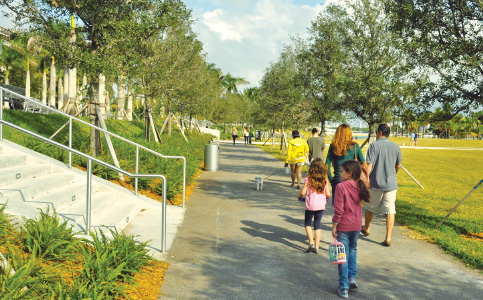To raise money, Miami looks at billboards in downtown parks
Advertisement

The City of Miami boasts two large waterfront parks, attracting scores of tourists and residents to the shore of Biscayne Bay.
This week the city commission is to consider allowing billboards in those parks.
On the agenda for the commission’s meeting today (9/22) is the first reading of an ordinance that would allow outdoor advertising signs at Bayfront Park, 301 Biscayne Blvd., and Maurice A. Ferré Park, 1075 Biscayne Blvd.
A portion of Maurice A. Ferré Park faces I-395 and the MacArthur Causeway to Watson Island and Miami Beach.
Sponsor of the proposed legislation is Commissioner Joe Carollo, who is chairman of the Bayfront Park Management Trust. The trust manages both parks.
The legislation would amend an existing ordinance entitled Administration/City-Owned Property/Outdoor Advertising Signs On City-Owned Property.
The proposal says in part, “Bayfront Park and Maurice Ferré Park have begun to attract large numbers of residents and visitors; and … Bayfront Park Management Trust manages Bayfront Park and Maurice Ferré Park to offset costs of maintenance on the City of Miami; and … the Trust has begun to host major events to amplify the enjoyment and use of the two parks for the community; and … the Trust can now attract more revenue to ensure funds necessary to improve and maintain the parks.”
The original ordinance allows outdoor advertising signs at three city-owned sites: James L. Knight Center, 400 SE Second Ave.; the Olympia Theater and Building/Gusman Center for the Performing Arts, 174 E Flagler St.; and Miami Children’s Museum, 980 MacArthur Causeway.
The ordinance defines outdoor advertising signs as “… (a) sign where the sign copy does not pertain solely to the use of the property, a product sold, or the sale or lease of the property on which sign is displayed and which does not solely identify the place of business as purveyor of the merchandise or services advertised on the sign.”
Criteria for approving the erection of outdoor advertising signs on city-owned property include: “Signs authorized under this section may be internally illuminated, but shall not be animated, revolving, whirling, or flashing signs.
“Moreover, any change of copy must not take place at intervals more frequent than eight seconds. The sign shall be integrated into the architecture or wall of the building, and shall not be a ground or freestanding sign or cantilever from the building.
“The design of the sign shall be consistent with the operation of the underlying venue, as determined by the director of planning and zoning,” the current ordinance reads.
The amendment would add this language: “Notwithstanding anything to the contrary signs located within Bayfront Park and Maurice Ferré Park shall not be required to be integrated into the architecture or wall of a building and may be ground or freestanding signs in order to promote as much green space in the venues, as possible.”
The city has had a dicey past when it comes to the proliferation of billboards and advertising signage, with past commissions working to limit their number and location.
Another item on the agenda up for a first reading is an amendment that if approved would expand the geographical area of the city where advertising signs – referred to as murals in the legislation – may be erected.
Much of that area is adjacent to I-95.
The proposal to expand the area was heard by the city’s Planning, Zoning and Appeals Board on Sept. 7 and resulted in a 10-0 vote recommending denial.
The proposal would also refine the provisions of mural appeals by specifying who may appeal, the timeframe in which to appeal, and require specificity in such appeals.


